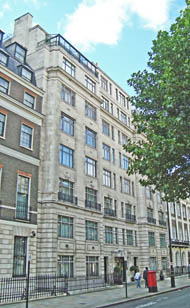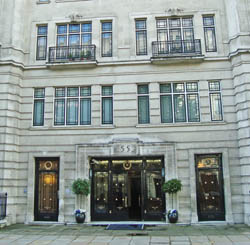Out-Patient Clinic
Physical medicine (out-patients only)
In August 1914, at the outbreak of WW1, Almeric Paget and his American wife, the heiress Pauline Payne Witney, founded the Almeric Paget Massage Corps at their house at 39, Berkeley Square. The masseuses were recruited by the Pagets, the qualification for enrolment being a certificate from the Incorporated Society of Trained Masseuses (ISTM), located at 157 Great Portland Street. The ISTM encouraged its graduates to join the Corps, which soon had enrolled 50 masseuses.
The demand for massage treatment greatly increased and the number of masseuses grew to over 100. Each masseuse treated between 30 and 40 patients a day. Treatments included not only massage, but also hydrotherapy and electrotherapy - galvanism, ionization, Schnee baths, diathermy and radiant heat.
Soon the Massage Corps was asked to establish an out-patients department in central London to relieve pressure on the London military hospitals.
The Massage and Electrical Out-Patient Clinic opened in November 1914 in a house loaned by Lady Alexander Paget at No. 55, Portland Place. The Executive Committee consisted of Miss Lucy Robinson (the Chairman of the ISTM), Miss (later Lady) Eleanor Essex French (daughter of Field Marshal John French, a member of the ISTM and the Secretary of the Massage Corps) and Dr Florence Barrie Lambert, the Medical Officer in charge of the Clinic, who gave her services voluntarily. The running expenses of the Clinic were borne by Mrs Almeric Paget, while most of the masseuses also worked voluntarily.
At first between 70 and 80 officers and soldiers received free treatment each day at the Clinic. The War Office agreed to pay the fares for all those attending, and soon some 160 a day were coming to the Clinic for treatment.
In March 1915 Sir Alfred Keogh, the Director-General of the Army Medical Service, inspected the Clinic and was so impressed that the service became the model for all Massage and Electrical Treatment Departments in all military and convalescent hospitals in the United Kingdom. Dr Lambert was asked to establish similar departments at Eastbourne, Epsom and Dartford. She was appointed to the Royal Army Medical Corps with the rank of major.
By the summer 110 military hospitals and institutions had been supplied and 150 masseuses were working for the Corps. Some 8,000 patients had been treated and 90,000 treatments given.
In November 1915 the War Office decreed that all massage workers should be appointed by the Massage Corps. By this time the Corps employed over 200 women, with many placed in most military hospitals. The Headquarters of the Corps remained at the Pagets' home in Berkeley Square.
By January 1916 blinded masseurs trained by St Dunstan's Hostel had gained the ISTM certificate of qualification and were also employed at military hospitals, relieving pressure on the Corps.
In 1916 the Corps had 900 members.
In November 1916 Pauline Witney Paget died at the age of 42 after a brief illness, shortly after she had established a large Massage Department at the Miller General Hospital. She had bequeathed her wealth evenly between her two daughters, and they carried on the funding of the Corps.
In December 1916 the Corps was asked to manage the massage services in all the military and auxiliary convalescent hospitals. It was renamed the Almeric Paget Military Massage Corps and received a government grant for its services (which had previously been paid for privately by the Pagets and public donations).
In January 1917, when the Corps had 1,200 masseuses, its members were permitted to volunteer for overseas duties and, by May 1919, some 56 masseuses had served in Italy and France.
In January 1918 the Corps had 1,500 members and, by the end of the war in November 1918, some 2,000.
The Massage Corps ceased activity in January 1919, when a Military Massage Corps was established under the control of the War Office and Ministry of Pensions, although its members were invited to join the new service.
By January 1920 only 600 members of the Corps remained.
The Clinic closed in 1920, but an Almeric Paget Clinic, financed by the British Red Cross, opened nearby at No. 2 Cambridge Gate.
Some 3.388 men and women had been members of the Corps at some stage during the war. Recovering officers and men continued to receive massage and electrical treatment in Red Cross Orthopaedic Clinics established by the Ministry of Pensions in London until the early 1920s.
Present status (August 2011)
The building has been converted into apartments.

No. 55 Portland Place.

The main entrance.
(Author unstated) 1915 Almeric Paget Massage Corps. British Medical Journal 1 (2822), 225.
(Author unstated) 1915 Massage for the wounded. British Journal of Nursing, 13th November, 406.
Carden-Coyne A 2008 Painful bodies and brutal women: remedial massage, gender relations and cultural agency in military hospitals, 1914-1918. Journal of War and Culture Studies 1, 139-158.
Leneman L 1994 Medical women at war, 1914-1918. Medical History 38, 160-177.
http://1914-1918.invisionzone.com
http://en.wikipedia.org
www.nationalarchives.gov.uk
www.scarletfinders.co.uk
Return to home page